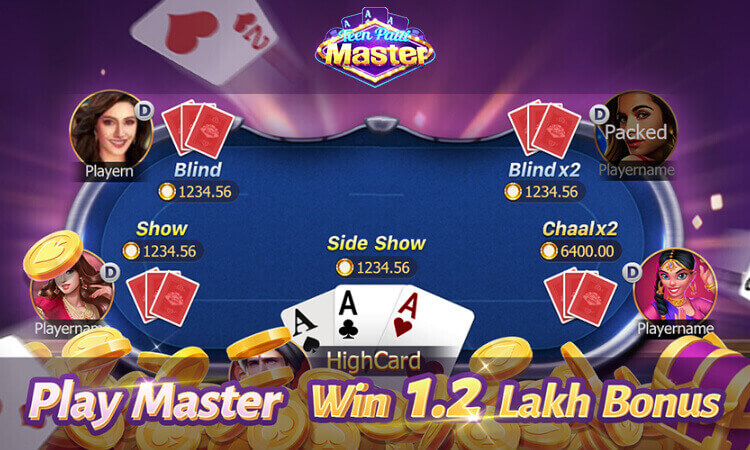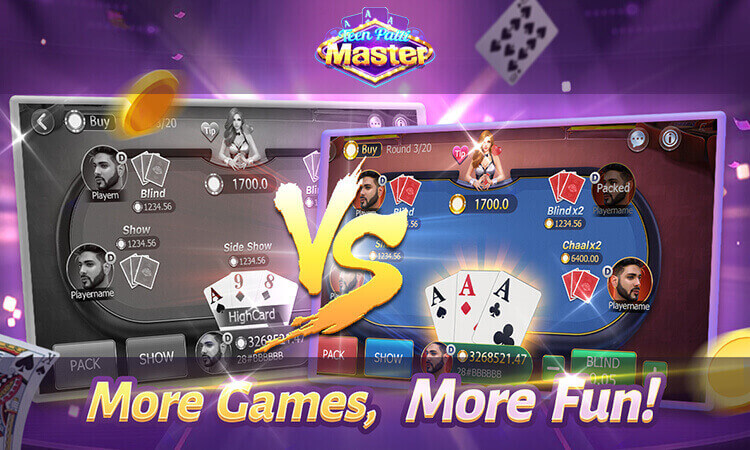Teen Patti: A Strategic Game Anchored in Mathematics
Teen Patti Master transcends mere chance, merging tactical play with mathematical principles. As a cornerstone of South Asian culture, its strategic allure is deeply rooted in numeracy. By understanding the mathematical framework of Teen Patti, even an average enthusiast can ascend to a strategic powerhouse. Our exploration will focus on probability, risk assessment, and judicious decision-making within the game. No matter if you're a veteran or a newcomer, the mathematics of Teen Patti can refine your approach and boost your prospects of triumph. Get ready to go beyond the hand you’re dealt and leverage the power of numbers to your advantage in Teen Patti.
Grasping Teen Patti's Fundamentals
Teen Patti, also known as "Flash" or "Flush", is a game that typically involves 3 to 6 players and is played with a standard deck of 52 cards, excluding jokers.
Teen Patti's Basic Rules
- Initiating the Game:Players are dealt three face-down cards. Before dealing, the boot amount is determined and gathered from each participant, establishing the pot's minimum stake.
- Betting Rounds:Players wager on who possesses the superior three-card hand. They can opt to view their cards (playing seen) or not (playing blind).
- Choosing Seen or Blind:Blind players bet half the amount required of seen players, influencing strategic betting and the game's pace.
- The Showdown:In the endgame, if two players remain, a show can be requested. The seen player must double the current stake for a seen show if the opponent is blind. For a blind show, the bet matches the current stake.

The Hierarchy of Winning Hands
- Trail or Set (Three of a Kind):Three identical rank cards, with A-A-A being the highest and 2-2-2 the lowest.
- Pure Sequence (Straight Flush):Three consecutive suit cards.
- Sequence (Straight):Three consecutive cards of differing suits.
- Color (Flush):Three same-suit cards, non-sequential.
- Pair (Two of a Kind):Two rank-matching cards. The higher value pair wins against another.
- High Card:This is the fallback when no other hand is made; the highest card wins, with tiebreakers going to the next highest card.
Understanding these rules and rankings is vital, as they are the foundation for any mathematical strategies in the game. The likelihood of achieving each hand type and the decisions based on these probabilities can significantly sway the game's direction.
The Significance of Probability in Teen Patti
To harness Teen Patti's mathematical aspects, one must comprehend probability's impact. Probability measures the chance of a specific hand occurring, calculated by the possible card combinations and their relation to the hand in question.
Essential Concepts in Probability
- Basic Probability Principles:Review core probability rules, including independent event theory and finite sample space probability calculations.
- Odds Calculation:Learn to compute the odds of drawing a particular hand by comparing favourable outcomes against unfavourable ones.
Applying Probability to Teen Patti's Hands
- Trail or Set:Given the finite combinations in a deck (52C3), determine the rare odds of drawing a trail.
- Pure Sequence and Sequence:Ascertain the probability of achieving a straight flush or a straight, recognizing the strength and rarity of these hands.
- Color, Pair, and High Card:These common hands have higher probabilities, and understanding these can guide betting or showdown decisions.
Illustrative Scena

rios: Probability in Action (Simplified)
Let's delve into a few simplified scenarios to see how an understanding of probability can influence gameplay in Teen Patti. These examples will demonstrate the practical application of mathematical odds in decision-making.
Scenario 1: Drawing a Trail
- Situation:You are dealt a hand, and you find yourself holding two cards of the same rank with one card to go. What are the odds of drawing a third for a trail?
- Mathematical Insight:With one card needed to complete the trail, and considering the 50 remaining unknown cards (assuming no other cards are visible), there are 2 favorable outcomes (the two remaining cards of the same rank).
- Probability Calculation: 2/50=0.04 or 4% chance of drawing a trail.
- Strategic Decision:Knowing the odds are low, you might decide to play conservatively unless other cues from the game suggest that opponents have weaker hands.
Scenario 2: Chasing a Pure Sequence
- Situation:Your hand consists of two consecutive cards of the same suit, and you're contemplating the likelihood of the next card completing a pure sequence.
- Mathematical Insight:Assume you hold a 7 and 8 of hearts. You need a 6 or 9 of hearts to complete the sequence. With 50 cards left, there are 11 cards of each suit remaining unseen.
- Probability Calculation:2/11 ≈ 0.18 or 18% chance of completing a pure sequence with the next card.
- Strategic Decision:An 18% chance is relatively high in the context of Teen Patti's rare hand combinations, which may justify a more aggressive betting stance if the pot is substantial and other players are showing signs of weakness.
Scenario 3: The Commonality of Pairs
- Situation:You're dealt a single pair and wondering how likely it is that another player also has a pair, potentially of a higher rank.
- Mathematical Insight:Given that pairs are more common, especially with more players in the game, the probability that at least one opponent has a pair is significant.
- Probability Calculation:This calculation is complex due to the multiple players and card combinations, but suffice it to say, the more players there are, the higher the chance of someone having a pair.
- Strategic Decision:If your pair is low, and you're facing aggressive betting from others, it might be wise to fold, as the risk of a higher pair out there is considerable.
Scenario 4: Holding a High Card
- Situation:Your hand does not form any recognized pattern, and you're relying on a high card.
- Mathematical Insight:High card wins are common but unpredictable, especially when two or more players are in a similar situation.
- Probability Calculation:With an ace (assuming it's the highest card not yet seen), you have the best possible high card, but the likelihood of winning depends on the remaining unseen cards and the number of opponents.
- Strategic Decision:If betting is low and the pot is large, you might stay in the game hoping others also lack strong hands. However, be cautious with high stakes, as the high card is often a weak hand to rely upon.
The Real-World Utility of Probability Knowledge
- Informed Betting:Probability insights assist in determining bet sizes.
- Bluffing:When high-ranking hands are improbable, a bluff might be strategic.
- Play or Fold Decisions:Probability can dictate whether to continue or abandon a hand.
- Reading Opponents:Aggressive betting might reveal strong hands or bluffs, informed by hand odds.
Probability equips players with the insights for educated gameplay decisions. While it doesn't ensure victory—luck being a factor—it does enhance game understanding and can tilt the odds of winning over time.




